In this post, we will discuss how underwater welding works. and Its types of underwater welding.
You can also download the PDF file of this article at the end of it.
Underwater Welding Process
In 1932 Russian metallurgist (Konstantin Khrenov) invented underwater welding. It is the process of welding at high pressure underwater.
When it is used in a dry environment called “hyperbaric welding”. And in the wet environment called “underwater welding”.
Dry welding is used in the preference of welding underwater when a high-quality weld is required. Due to the increased control in the situations which can be done through the use of before and after weld heat treatment.
Thus, when a very high-quality weld is required, dry hyperbaric welding is used. Research is underway to use dry hyperbaric welding at a depth of 1,000 meters (3,300 feet).
In general, assuring the integrity of underwater welds can be complex. (But it is possible using various non-destructive testing applications). Mainly for wet underwater welds.
There are two methods of underwater welding 1. Wet welding, and 2. Dry welding.
Applications of hyperbaric welding.
- It is usually used for the repair of ships, offshore oil platforms, and pipelines.
Read Also: 23 Types of Metals and Their Properties [Explained]
Types of Underwater Welding
There are mainly two types of weldings performed underwater:
- Wet Welding
- Dry Welding
#1 Wet Welding
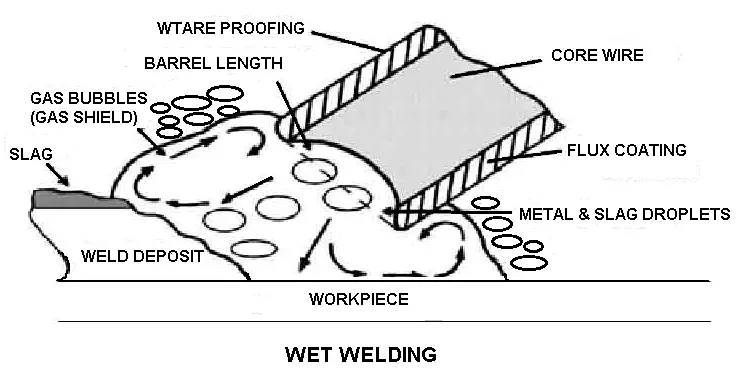
This method is done underwater. This involves the use of designed welding rods and involves the same process used in standard welding.
Wet underwater welding exposes the diver and electrode to the water and surrounding elements. Divers use around 300–400 amps of D.C. power to charge their electrodes, and they weld using varied forms of arc welding.
Due to hydrogen cracking, the process is usually limited to low-carbon equivalent steals, especially in greater depth. Wet welding is done with the same equipment used for dry welding, but the electrode holders are designed to cool the water and are heavier insulating.
Advantages of Wet Welding:
- The wet welding process is faster and cheaper.
- There is no habitat.
- high tensile strength.
- Ease of access to weld spots.
There are different types of wet welding,
#1 Shielded Metal Arc Welding
This method, often called stick welding, is often utilized in wet welding projects. Welders use this versatile and inexpensive process to create an electric arc between the electrode and the structure being welded.
#2 Flux Core Arc Welding
This method employs a filler material tube with a flux at its core. The electrode wire is supplied automatically via the welding guns, allowing for precise and controlled welds.
#3 Friction Welding
Friction welding combines heat and friction to fuse materials and can be done underwater.
Read Also: Different Types of Welding Positions [Pictures & PDF]
#2 Dry Welding or Hyperbaric Welding
![Underwater Welding [Hyperbaric Welding]](https://www.theengineerspost.com/wp-content/uploads/2018/06/HYPERBARIC-WELDING.png)
Hyperbaric welding is the process by which a chamber is sealed around the structure that is to be welded. It is filled with a gas (usually a mixture of helium and oxygen, or argon), which then forces water outside the hyperbaric region. This allows for a dry environment in which to perform the weld.
Advantages of Dry Welding:
- It has high quality of welding.
- It has welder or diver safety.
- Dry welding has non-destructive welding.
- It has surface monitoring.
Following are the types of dry welding,
#1 Habitat Welding
This approach involves a tiny chamber and is frequently used for hot work. Gases are continuously pumped through the chamber to keep the pressure slightly higher than outside while maintaining a breathable atmosphere.
#2 Pressure Welding
Pressure welding employs explosive forces and/or friction. It includes diffusion welding, explosion welding, gas welding, resistance welding, ultrasonic welding, and friction welding.
#3 Dry Spot Welding
This method creates a dry environment by covering the weld area with tiny chambers. To form the weld, an electrode is inserted into the chamber.
#4 Dry Chamber Welding
This technique uses a hyperbaric chamber to provide a dry atmosphere for the weld, much as habitat welding. The chamber is smaller in this case, though, and can only fit the welder’s upper upper body.
#5 Gas Tungsten Arc Welding
Often referred to as “TIG welding,” this process makes use of a second wire for the filler material and a non-consumable tungsten electrode to produce an electric arc.
#6 Gas Metal Arc Welding
This method also referred to as “MIG welding,” uses a welding gun that automatically feeds filler wire while pumping a shielding gas to keep the area of welding safe.
#7 Plasma Arc Welding
In plasma arc welding, an electrode is used to create an electric arc. This electrode, commonly constructed of sintered tungsten, is situated in the torch’s body to keep the arc separate from the inert gases.
Read Also: Basic Welding Tools and Equipments [Pictures & PDF]
Underwater Welding Equipment
To weld properly underwater, a commercial diver uses five main tools:
Diving Helmet
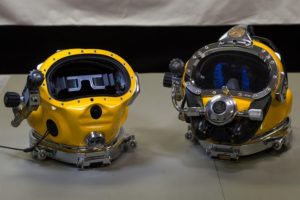
The figure shows the diving helmet for the underwater welding process. It is essential to wear a safe diving helmet for their work. During the welding process helmet, protect our eyes and face.
Also, the diving helmet allows breathing for the welder-diver underwater, so that it used for underwater purposes. A welding screen that attaches to the front of their mask for eye protection. Some of these welding screens flip up or down like a welding hood, and they all come in different colors.
Underwater Welding Diving Accessories
Welder-divers will use these diving accessories:
- Diving knife
- Umbilical cord
- Harness
- Gas panel and compressor
- Bailout gas
- Knife switch
#1 Diving knife

It is a tool for every situation. Whether they need to cut into project material, wedge open a door, or free themselves from a Critical condition a diving knife works.
#2 Umbilical cord
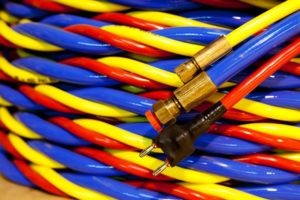
This is gas is pumped from the diver too and from the surface.
#3 Harness
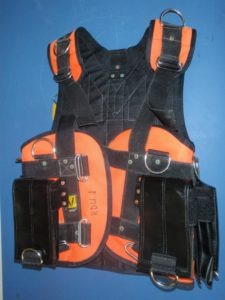
To keep the diver floating in one place while doing his work.
#4 Gas Panel and Compressor
A qualified team controls the gas gauge and keeps the steady supply of air coming below the diver. Divers also observe these directly. Many use a low-pressure gas because of its low maintenance is almost unlimited air supply.
#5 Bailout Gas

It is used for emergencies, in the case of poor SSA equipment, this gas is usually used by the diver as a secondary gas supply. It comes in the form of a small SCUBA tank.
#6 Knife Switch
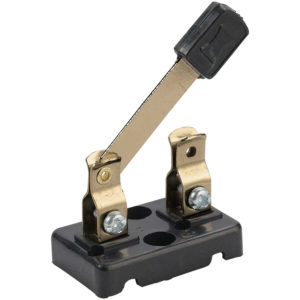
Not the same as a diving knife. It is used when using electrical appliances underwater like wet welding. Built in the form of a simple liver, it regulates the flow of electricity from the upper side to power your device.
Read Also: Types of Welding Machines & Their Applications [PDF]
Diving Suit
For diving purposes, divers must use a dry suit because it provides better protection against climate control than a wetsuit.
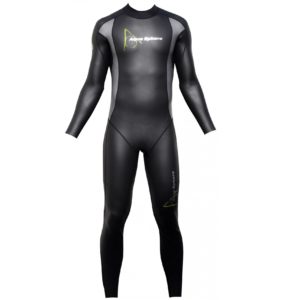
Depending on the environment in which you diving, dry suits either are neoprene, rubber, or shell.
However, as an extra external layer of protection, some underwater welders wear coveralls at the top of their suit.
If a molten metal directly hits its suit, then it can burn through it. Coverall prevents it from occurring.
To protect of hands, welder divers wear thick, rubber linemen’s gloves over several pairs of latex. To prevent the water from being in gloves, they can snap a rubber band around the wrist section.
Electrodes
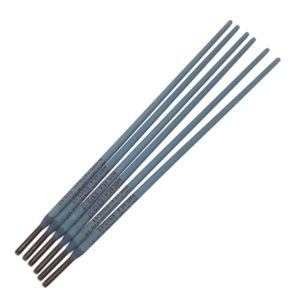
The electrodes are the most important tool of underwater welding it provides materials for the weld. underwater electrodes should be extremely water-resistant coating and have high yield strength.
Water-resistant coating: The longer it can hold up in a hostile marine environment, the better.
High yield strength: Better quality material in the electrode provides a high-density weld that will last for a long time.
Stinger
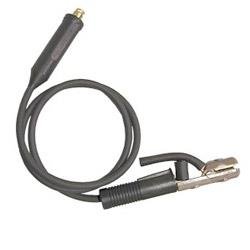
Stingers hold the electrodes, and they are made of lightweight plastic materials to reduce the possibility of twinge and fatigue. The stinger has the following characteristics:
- It should be insulated.
- It should be ergonomic and lightweight.
- Angled Correctly.
Power Supply
For every welding process, the power supply must be required. In underwater welding, DC power source is usually used.
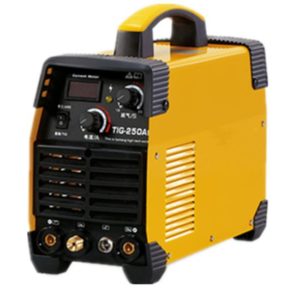
The power source for an underwater manual metal arc (MMA, SMA / SMW) welding should be a direct current welding generator type, which can produce at least 300 A on a 65V open circuit (OC).
The equipment welding circuit should include a DC circuit breaker (twin pole single action, 400 A minimum).
Conclusion
So now, we hope that we have cleared all your doubts about the Underwater Welding Process. If you have still any doubts about the “Types of Underwater Welding” you can contact us or ask in the comments. If you like our article, then please share it with your friends.
Subscribe to our newsletter to get notified when we upload new posts.
Download PDF of this article:
You may be interested in reading more articles on welding:
- What are the Types of Welding Joints (Explained in Detail)
- Common Types of Welding Defects [Causes & Remedies]
- What is the Difference Between Tig and Mig Welding?
Other articles:
This article is so much helpful. I learn many things from this article. If you give all the prices of all equipment, it’ll be helping more.
Glad you liked it! and Sure will do that 🙂
Types of welding wires for underwater workWhat types of welding wires to work under water. With the number
For underwater welding work, underwater welding electrodes are used these electrode has a water-resistant coating and high yield strength. checkout electrodes here